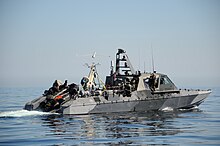Boeing Insitu ScanEagle
The Boeing Insitu ScanEagle is a small, low-cost, long-endurance unmanned aerial vehicle (UAV) built by Insitu, a subsidiary of Boeing. The ScanEagle was designed by Insitu based on the Insitu SeaScan, a commercial UAV that helped fishermen look for fish. The ScanEagle continues to be upgraded with improved technology and reliability.
| Role | unmanned aerial vehicle |
|---|---|
| National origin | United States |
| Manufacturer | Boeing Defense, Space & Security Insitu |
| First flight | 20 June 2002 |
| Introduction | 2005 (United States Navy) |
| Primary users | United States Navy United States Marine Corps Australian Army Canadian Army Tunisian Army |
Design and development
ScanEagle is a descendant of another Insitu UAV, SeaScan, which was conceived of as a remote sensor for collecting weather data as well as helping commercial fishermen locate and track schools of tuna. ScanEagle emerged as the result of a strategic alliance between Boeing and Insitu. The resulting technology has been successful as a portable Unmanned Aerial System (UAS) for autonomous surveillance in the battlefield, and has been deployed since August 2004 in the Iraq War.
ScanEagle carries a stabilized electro-optical and/or infrared camera on a lightweight inertial stabilized turret system integrated with communications range over 62 miles (100 km), and flight endurance of 20+ hours. ScanEagle has a 10.2-foot (3.1 m) wingspan a length of 4.5 feet (1.4 m) and a mass of 44 pounds (20 kg) and can operate up to 80 knots (92 mph; 150 km/h), with an average cruising speed of 48 knots (55 mph; 89 km/h). Block D aircraft featured a higher-resolution camera, a custom-designed Mode C transponder and a new video system. A Block D aircraft, flying at Boeing's test range in Boardman, Oregon set a type endurance record of 22 hours, 8 minutes.

ScanEagle needs no airfield for deployment. Instead, it is launched using a pneumatic launcher, patented by Insitu, known as the "SuperWedge" launcher. It is recovered using the "Skyhook" retrieval system, which uses a hook on the end of the wingtip to catch a rope hanging from a 30-to-50-foot (9.1 to 15 m) pole. This is made possible by high-quality differential GPS units mounted on the top of the pole and UAV. The rope is attached to a shock cord to reduce stress on the airframe imposed by the abrupt stop.
Each ScanEagle system costs US$3.2 million (2006). A complete system comprises four air vehicles or AVs, a ground control station, remote video terminal, and the Skyhook launch and recovery system.
Specifications
Data from USAF Scan Eagle fact sheet
General characteristics
- Crew: none on-board
- Length: 3.9 feet (1.19 meters)
- Wingspan: 10.2 feet (3.1 meters)
- Height:
- Loaded weight: 39.7 lbs (18 kilograms)
- Powerplant: 1 × 3W 2-stroke piston engine, 1.5 hp
Performance
- Maximum speed: 55-80 mph
- Endurance: 20 + hours
- Service ceiling: 16,000 feet above ground level (4,876 meters) ()
Avionics
High resolution, day/night camera and thermal imager
The information contained on this page is unclassified, approved for public dissemination and is released under CC-BY-SA Licensing Agreement.

